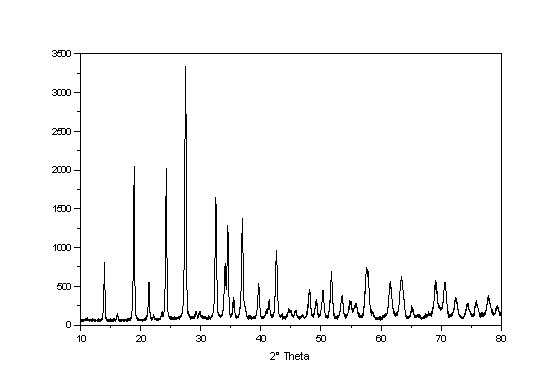
SYNTHESIS OF CANCRINITE UNDER
APPLICATION OF ORGANIC SOLVENTS:
AN OPPORTUNITY TO ACHIEVE A TEMPLATE-FREE
CHANNEL SYSTEM?
Britta Posnatzki1, Michael Fechtelkord, Josef- Christian Buhl
Institut für Mineralogie, Universität Hannover, Welfengarten 1, D - 30167 Hannover, Germany
e-mail: B.Posnatzki@mineralogie.uni-hannover.de
Keywords: Hydrothermal
synthesis, organic solvents, cancrinite, MAS NMR spectroscopy
Cancrinite is a well-known natural zeolite having a Si/Al- ratio of unity which is readily synthesized in systems consisting of Na2O - SiO2 - Al2O3 - H2O in the presence of a large variety of salts [1]. The characterizing structural feature is a single 12- ring channel parallel to the c- axis [2]. This one-dimensional channel system with a diameter of 6.8 A is a perfect matrix for the enclathration of orientated molecules [3, 4]. The insertion of organic macromolecules as reactive compounds for later catalytic reactions is possible. Furthermore, the application of small organic precursor molecules is desirable which can be removed by heating to provide a template-free channel system. In cancrinites prepared under well-studied hydrothermal conditions the pores are blocked up by anions like CO32-, NO3- or SO42-. Attempts to remove these templates by calcination lead to decomposition of the framework structure.

Fig.1: XRD-pattern of cancrinite synthesized in a NH3- solution
Synthesis of zeolites in organic systems is a common way for
the formation of novel structures, compositions or special
characteristics. Since Bibby and Dale [5] prepared
silica-sodalite in ethylene glycol, several zeolites with known
structures have been synthesized in organic, non-aqueous media.
Reports on cancrinite syntheses in organic solvents are scarce:
Tab. 1: Reaction compounds
| Alumina-Source | Silica-source | Solvent | Base |
| Al(OCH[CH3]C2H5)3 | Si (OCH3)4 | 32%-NH3 | NaOH |
| Al(OCH[CH3]2)3 | Si(OC2H5)4 | butane-1,3-diol | NaOCH3 |
| Si(OC3H7)4 | butane-1,4-diol | NaOC2H5 | |
| NaOC3H5 | |||
| NaOC4H9 |
Milestone et al. [6] and Liu et al. [7] report about the
formation of sodalite and cancrinite in 1,3- and 1,4-butane-diol.
These cancrinites can absorb water, hexane and cyclohexane [7].
Vaughan [8] has developed ECR-5 - a cancrinite structure-type
material - under application of ammonia and aqueous ammonia
solutions. ECR-5 is distinguish by a high silica content and an
increased adsorption capacity compared to conventional
cancrinite.
In this paper we report about synthesis of cancrinite under application of organic solvents. The reaction compounds used are listed in Table 1. Syntheses were carried out in coated stainless steel autoclaves at temperatures from 373 K to 473 K for a duration up to 2.5 weeks.
The products were analysed by X-ray powder diffraction, IR- and MAS NMR spectroscopy.
[1] Barrer, R.M. et al., J. Chem .Soc. A,
(1970), 1523
[2] Jarchow, O., Z.Krist., 122, (1965),
407
[3] Lindner, G.G. et al., J. Solid State Chem., 126
(1996), 50
[4] Barnakov, Y.A. et al., Inorg. Mater., 31
(1995), 748
[5] Bibby, D.M., Dale, M.P.; Nature; 317; (1985);
157
[6] Milestone, N.B., Hughes S. M. and Stonestreet P. J., Stud.
Surf. Sci. Catal., 98, (1995) 42
[7] Liu, C., Li, S., Tu K. and Xu R., J. Chem. Soc. Chem.
Commun., (1993) 1645
[8] Vaughan, D.E.W., E. Patent A - 190,90, (1986)